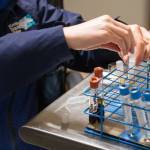Research Insights: Processing Blood Samples

Blood collection is an essential element of the investigative work done at Kentucky Equine Research. Scientists look for specific compounds, called analytes, in blood, such as proteins, nutrients, and hormones. These analytes provide many clues to homeostasis and cellular metabolism. Tens of thousands of blood samples have been collected and processed since the company initiated its research efforts in 1988.
Laboratory tests typically require the use of either whole blood or blood separated into a specific component. Whole blood comprises four primary components: red blood cells, white blood cells, platelets, and plasma. Red blood cells contain hemoglobin and are responsible for carrying oxygen throughout the body, and white blood cells are immune cells that defend against infection and foreign pathogens. Granulocytes, monocytes, and lymphocytes are examples of white blood cells. Platelets play a role in blood clotting. Plasma is the noncellular, liquid component of blood that is responsible for circulating proteins, hormones, waste products, water, salts, enzymes, nutrients, and other molecules in the body.
To collect plasma, red blood cells, or whole blood, whole blood samples are collected into a vacuum tube containing an anticoagulant to prevent clotting. At Kentucky Equine Research, if we wish to save whole blood, it can be divided into smaller storage tubes and frozen for later analysis. If we want red blood cells or plasma, however, an isolation technique must be employed, such as centrifugation. To do this, the tube of whole blood is placed in a machine that spins the sample at a high speed to separate the lighter plasma from the heavier red blood cells. After centrifugation, two distinct components appear in the tube: the plasma on top and the red blood cells at the bottom. Plasma is a translucent yellow liquid that contains all blood components without the red blood cells.
While serum is similar to plasma, it does not contain any clotting factors. To process blood for serum, whole blood is collected in a vacuum tube that does not contain anticoagulant. The sample sits at room temperature for about an hour to allow a clot to form. Then, it is spun in the centrifuge to separate the serum from the clotting factors and red blood cells. Serum, like plasma, appears as a yellow liquid.
Once serum, plasma, or red blood cells have been separated through centrifugation, these components can be collected and pipetted into smaller storage tubes, which are typically frozen until analysis. The aliquoted samples may remain frozen at -20° C for short-term storage before being transferred to a -80° C freezer for long-term storage. Freezing maintains sample integrity for later analysis.
Blood samples can be analyzed directly after collection or frozen for later analysis. If a laboratory has in-house capability, samples may be analyzed on-site or sent to outside laboratories. Common blood analysis methods include enzyme-linked immunosorbent assays (ELISAs), blood gas analysis, blood chemistry analysis, and hemostasis analysis, among others.
This article was written by Emily Robyn, a year-long intern at Kentucky Equine Research. As part of the intern program, participants are asked to contribute to Equinews occasionally. Learn more about the internship program.








